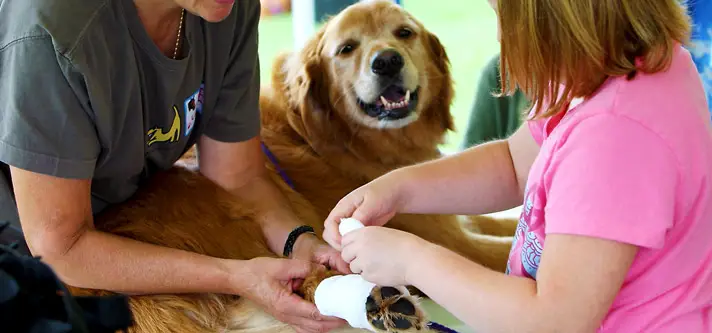What do you do if your dog is suffering from poisoning, bleeding, burn or heatstroke? Dr Joanne Sillince from Pets Australia shares some first aid tips that could mean the difference between life and death for your dog.
Knowing what to do in an emergency situation can save your dog’s life at home or on the road but it is not a substitute for veterinary care. “Virtually all first aid administered to your dog needs to be followed by immediate veterinary care,” says Dr Sillince.
Before you begin first aid, remember your safety comes first. Injured or frightened dogs bite readily. Using a muzzle can help to prevent your dog biting and possibly putting you into hospital!
Poisoning
If your dog’s skin or eyes are exposed to a poison (eg cleaning or gardening products), check the product label for the first aid instructions and do the same for your dog. Call your vet immediately. Collect in a plastic sealable bag anything your dog may have vomited or chewed for the vet to examine.
Seizures
Seizures can last be frightening. Move your dog away from any furniture or other object that might cause injury. Do not restrain your dog or touch its tongue. After the seizure has stopped, or if it hasn’t stopped within 30-60 seconds, take the dog to the vet immediately.
Broken bones
Unless the break is in the facial bones or the dog has difficulty breathing, muzzle your dog to keep you safe and call your vet for pick-up. If this is not possible, use a board, blanket or towel as a stretcher. You may have to wrap the pet in a towel or blanket to keep it warm or calm, but don’t move or put pressure on the break. Don’t try to bandage the area or make a homemade splint as it can cause more harm than good. Keep the broken area as still as possible.
Bleeding
Press a clean, thick gauze pad or clean cloth over the wound and keep firm, even pressure on it with your hand for a few minutes until the blood starts to clot. If the bleeding is severe or not clotting, apply a bandage and pressure over the wound. Take your dog to the vet immediately as it can be quickly be life-threatening.
Signs of internal bleeding include bleeding from the ears, nose, mouth, anus, coughing up blood, blood in urine, pale gums or collapse. Keep your dog warm and quiet as possible and get the dog to a vet.
Burns
For chemical burns, follow the treatment instructions on the label and get your dog to a vet. While water is often used, it can aggravate some chemicals.
For heat burns, flush the burn immediately with large quantities of cold, clean water for up to 20 minutes. If the skin is brown or black or there is blistering, take the dog immediately to the vet after flushing with water.
Heatstroke
Never leave your dog in the car on warm days as the temperature in a car can rise very quickly to dangerous levels. Dogs can get heatstroke very easily, especially flat-nosed breeds, and need immediate veterinary care for the best chance of survival. Death can occur in as little as 10 minutes.
Move your dog out of direct sunlight, offer a drink of cold water and wet down with cold running water. Sit your dog on a cool pack if possible. Use fans or air conditioning to enhance cooling. DO NOT wrap with wet towels as these stop heat escaping. Unless your dog is noticeably better within 5 minutes of this treatment, get to a vet ASAP with the car air conditioning trained on the animal!
Choking
Signs of choking include difficulty breathing, panic, excessive pawing at the mouth, choking sounds, gurgling and blue lips/tongue. Using caution, look into your dog’s mouth for any visible foreign object. Gently try to remove it with pliers or tweezers, being careful not to push it further down the throat or damage delicate tissues, and get to the vet.
If you can’t remove the object and your pet collapses, place both hands on the side of your dog’s rib cage and apply firm quick pressure. Or lay your dog on its side and strike the rib cage firmly with palm of your hand to try to push air out of the lungs and push the object out from behind. If this doesn’t work, phone your vet for further emergency instructions.
Not breathing
If your dog has stopped breathing, check there are no foreign objects blocking your dog’s airway and open the airway by gently pulling the tongue forward.
Begin performing rescue breathing by closing your dog’s mouth with your hand and, sealing your mouth onto your hand, breathe directly into its nose until you see the chest expand. Do not push against resistance, as you can burst the lungs. Continue the rescue breathing once every 3 – 5 seconds
No heartbeat
DO NOT attempt CPR – even for practice – if your dog has a heartbeat. You can seriously disrupt normal heart function.
If your dog has no heartbeat, lay your dog on its right side on a firm surface. Locate the heart in the lower half of the chest on the left side, just behind the elbow of the front left leg. Place your hand over the heart. Press on the heart in short sharp bursts, at least 3cm for medium-sized dogs, and up to 10cm for larger animals and (with less force for smaller animals).
Press down as fast as you can – 120 beats per minute, if possible. Don’t worry about rescue breathing; the pushing moves air into the lungs. Continue until you can hear a heartbeat and your dog is breathing regularly. Get to your vet immediately.
Do you want to learn more about emergency first aid for dogs or first aid supplies to keep at home? Pet first aid courses are available through many organizations, such as Pets Australia.


